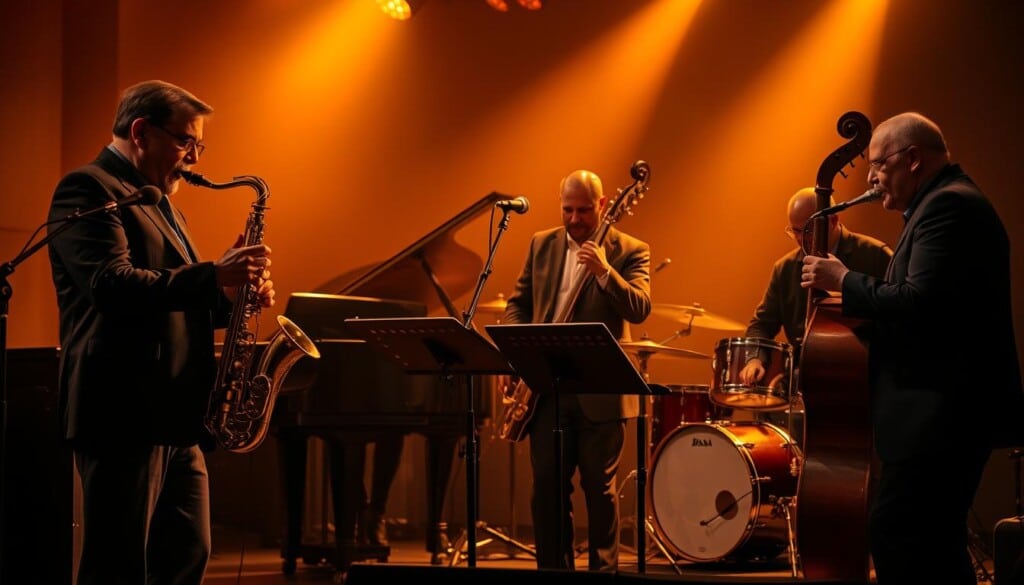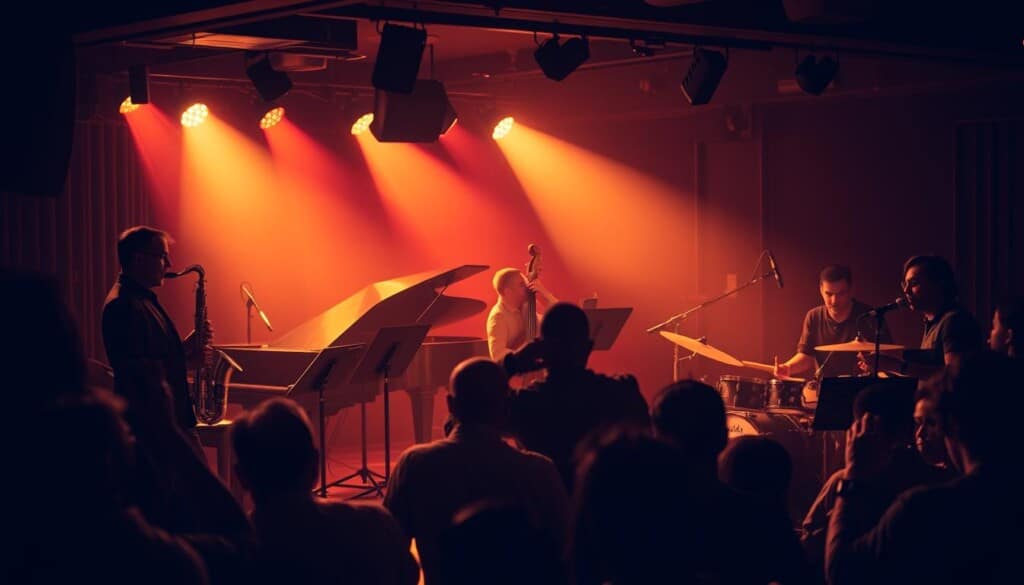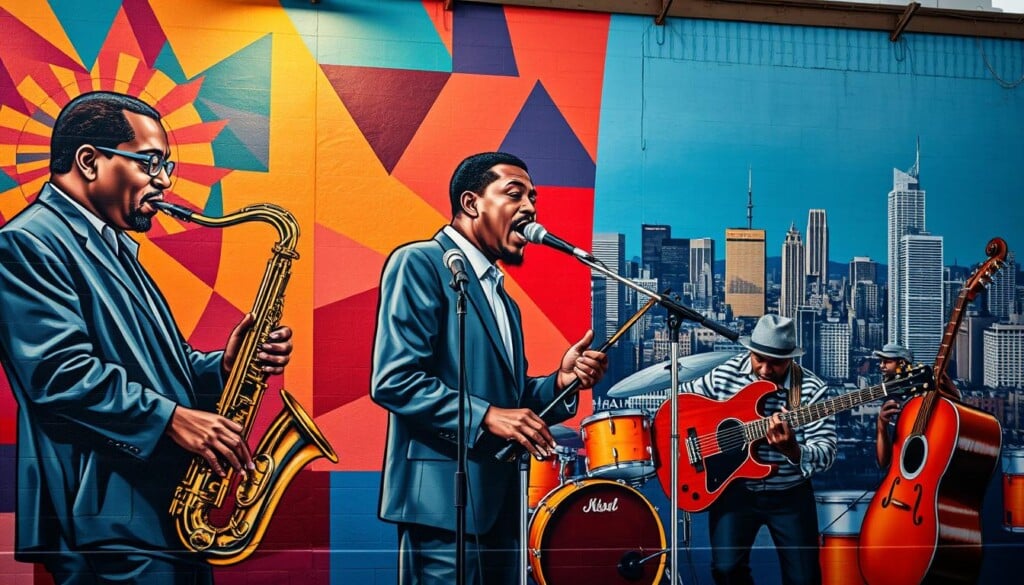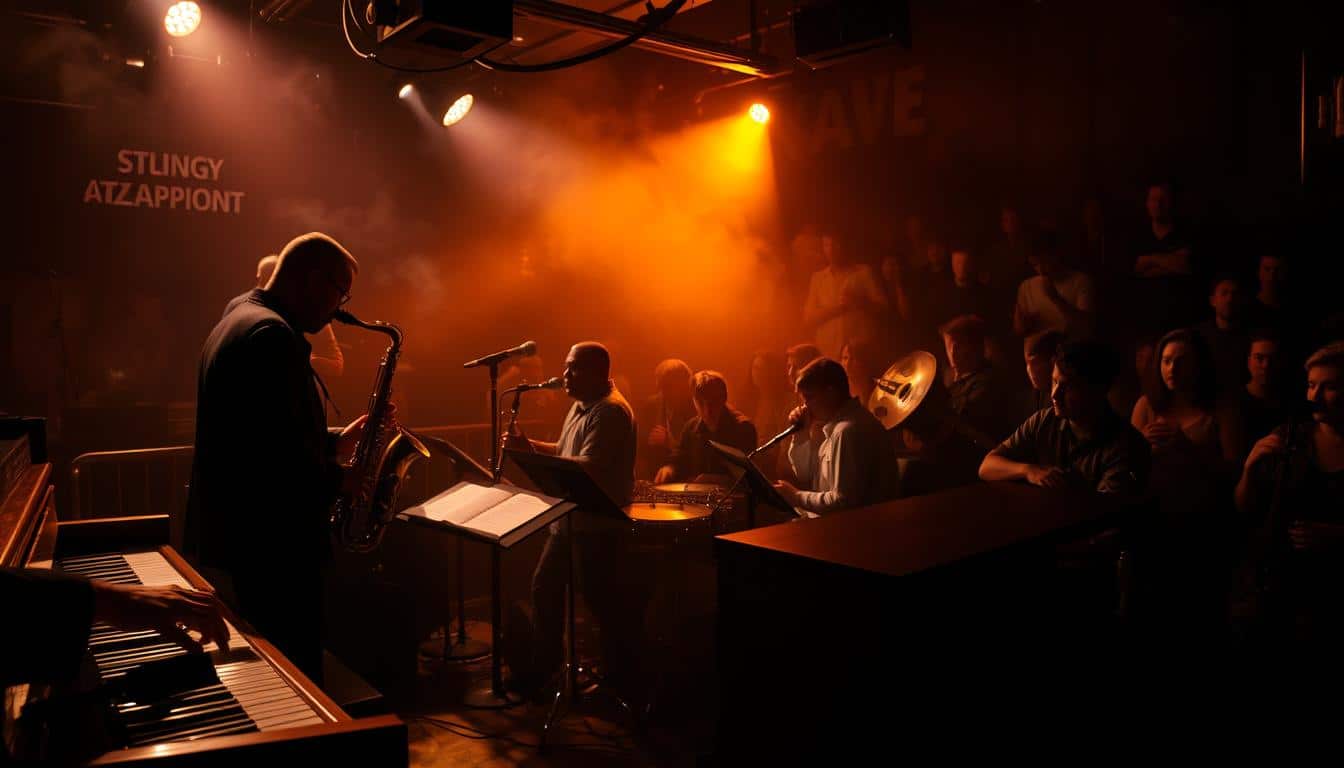What if Jazz & Blues music echoes our shared experiences of pain and joy? This thought invites us to explore these genres deeply. They come from African American communities, telling stories of history and culture.
Through their rhythms and melodies, jazz and blues show the growth of sound and culture. They share the stories of jazz musicians and blues artists. As we explore, we’ll discover why Jazz & Blues are key to America’s music.
Key Takeaways
- The origins of jazz and blues music resonate with deep cultural significance.
- Emotional expression is a hallmark of both jazz musicians and blues artists.
- Jazz and blues reflect complex historical narratives.
- The interplay of rhythms and melodies defines the auditory experience.
- The cultural impact of jazz continues to shape modern music.
The Rich History of Jazz & Blues Music
Jazz and blues music come from a rich mix of history, culture, and music. Jazz started with African American work songs and spirituals. Blues music also grew from African American struggles and experiences.
Origins and Evolution
Jazz mixes African music with European styles, creating a lively form of expression. African Americans moving to cities helped blues music grow. It became known for its emotional songs and unique rhythms.
Key Influences
Many jazz influences come from legendary improvisers and ragtime and blues. The Harlem Renaissance boosted jazz and blues, introducing them to more people. This time helped jazz and blues become key parts of American music.
Cultural Impact
Blues has a big impact beyond music, shaping American views and culture. Jazz and blues show the African American experience, touching on themes like struggle and love. These genres keep influencing art, staying important in American culture.
Notable Artists Who Shaped Jazz & Blues
Many artists have shaped jazz and blues over the years. Their talent and new styles have changed music forever. Some have become legends, leaving a lasting impact on music.
Legends of Jazz
Louis Armstrong changed jazz with his trumpet and voice. He mixed improvisation with melody in a new way. Billie Holiday brought storytelling to jazz, influencing many singers.
These artists show the skill and passion of jazz legends.
Icons of Blues
Muddy Waters is called the father of modern Chicago blues. His guitar and voice set the stage for blues. B.B. King combined guitar solos with deep vocals, showing the emotional side of blues.
These icons have deeply influenced blues music.
Contemporary Influencers
New artists keep jazz and blues alive today. Musicians like Kamasi Washington and Gary Clark Jr. mix old and new styles. They push the limits of jazz and blues, keeping their legacy alive.

Essential Instruments in Jazz & Blues
Jazz and blues rely on a few key instruments. The saxophone in jazz is a main voice, bringing out emotions with its deep sounds. The guitar in blues is also vital, adding rhythm and melody. Jazz drums tie everything together, creating a unified sound.
The Role of the Saxophone
The saxophone in jazz is very versatile. It can play soft melodies or loud, sharp sounds. This lets musicians show a wide range of feelings. Famous saxophonists have used it to explore new sounds and feelings.
The Significance of the Guitar
The guitar in blues is both the rhythm and the melody. Its chords form the base, while solos add excitement. Without the guitar, blues wouldn’t be the same.
adding rhythm with drums>
Jazz drums are key in setting the rhythm for jazz and blues. They help keep the beat and add variety to the music. The drums, saxophone, and guitar work together, making drums essential in jazz and blues.
The Connection Between Jazz & Blues
Jazz and blues share a deep bond, rooted in African American culture. They both use rhythm, improvisation, and melody. This creates a rich sound tapestry.
Shared Roots and Styles
Jazz and blues started together, influencing each other. Blues’ emotional stories and unique chords shaped jazz. This mix has led to many jazz styles, showing their lasting impact.
The Emotional Expression
Music’s emotional heart beats in jazz and blues. Artists share personal stories through their music. This connection makes each note feel like a part of our lives.
Fusion in Modern Music
Now, jazz and blues blend in new ways, like jazz-funk and soul jazz. These styles bring in fresh sounds, keeping the genres alive. For music lovers, checking local listings can help find events.
Popular Jazz & Blues Genres
The world of jazz and blues is full of different genres. Each one adds its own special touch to music. Soul jazz is known for its gospel influences and heartfelt performances. Delta blues is all about raw emotion and telling stories through music. Smooth jazz, on the other hand, is all about relaxing vibes and jazz’s improvisational spirit.
Soul Jazz
Soul jazz started in the late 1950s, blending jazz and rhythm-and-blues. It’s filled with gospel sounds, making it both emotional and lively. Musicians use organs, pianos, and saxophones to create warm tunes and deep beats. This music is more than just something to listen to; it’s an experience.
Delta Blues
Delta blues comes from the Mississippi Delta and is all about heartfelt stories. It’s played on acoustic guitars and with powerful vocals. This genre gives a real look at life’s challenges through personal stories, connecting listeners to the artist’s feelings.
Smooth Jazz
Smooth jazz is known for its complex arrangements and calm sounds. It uses synthesizers and soft drums, mixing jazz with gentle melodies. It’s perfect for places where people want to relax, like cafés and lounges, where it adds a touch of class.
Experiencing Jazz & Blues Live
Live jazz and blues events create a special bond between fans and artists. Across the U.S., many venues are the heart of this music culture. These places, from cozy clubs to big theaters, offer unique settings that make each show special.
Top U.S. Venues
Preservation Hall in New Orleans is a historic spot for jazz. Its small size makes you feel the music deeply. The Apollo Theater in Harlem is famous for its legendary shows and new talent. Chicago’s Blues Festival is a top spot for blues fans, with great artists and fun events.
Festivities and Events
Cities all over celebrate jazz and blues with festivals every year. These festivals have famous performers, workshops, and jam sessions. They let you dive into the music’s rich traditions and show its cultural value.
Local Performances
Local venues showcase the unique styles of artists in your area. These small shows, in clubs or outdoors, connect you with the artists. Supporting local jazz and blues helps your community and keeps the music alive.

Discovering Local Jazz & Blues Communities
Exploring local jazz clubs and blues communities is exciting. These places are where musicians practice and fans enjoy live music. They celebrate the rich history of jazz and blues.
Finding Local Clubs
Local jazz clubs are more than places to hear music. They are centers of creativity and socializing. People can find unique spots in their neighborhoods, with music for all tastes.
Going to these places helps artists and brings people together. It strengthens the bond among music lovers.
Meetups and Jams
Community jazz events and blues meetups are key for musicians. They offer chances to work together and meet others. Open jam sessions let local talent shine and fans enjoy the moment.
These events help grow the next jazz and blues stars. They help artists connect and grow in their communities.
Community Impact
Local jazz clubs and events do more than just play music. They help keep cultural heritage alive and boost local identity. By supporting these places, we ensure jazz and blues continue to be enjoyed.
This commitment helps preserve the legacy of these genres. It lets future generations enjoy live music.
How to Support Local Jazz & Blues Artists
Supporting local jazz and blues artists is key to a vibrant music scene. By engaging with local talent, we enrich our lives and help them keep creating. Events, music merchandise, and local business partnerships are all important ways to show support.
Attending Live Shows
Attending live shows is a powerful way to support local artists. These performances let musicians share their passion with us. It’s a chance to make memories and help artists keep doing what they love.
Every ticket sold helps them make a living and grow the local music scene.
Purchasing Music and Merchandise
Buying music merchandise like albums and t-shirts helps local artists a lot. These sales fund their projects and help them reach more people. Many artists depend on merchandise sales to support their work.
By buying their products, we support them and help spread their music in our community.
Joining Local Business Initiatives
Getting involved in local business initiatives helps artists and businesses work together. This can include sponsoring events or creating unique merchandise. LocalZ is a great place to find these opportunities and support local jazz and blues artists.

Engage with LocalZ for Jazz & Blues Experiences
LocalZ is a key tool for diving into jazz and blues in your area. It offers a wide range of music listings, making it easy to find live shows near you. Whether you prefer cozy clubs or big concert halls, LocalZ helps you find the right spot for great music.
Searching Listings for Music Venues
LocalZ’s easy-to-use interface makes finding venues a breeze. You can sort by genre, location, and date to find the perfect show. This makes it easy to explore different music scenes and connect with local artists.
Choosing Local Artists
Supporting local jazz and blues artists is key. LocalZ showcases many musicians, helping you discover new talent. This focus on local artists strengthens the community and adds depth to local music experiences.
Enjoying Your Local Scene
LocalZ does more than list shows; it highlights community events too. Going to these events creates a space for music lovers to come together. By joining in on these events, you support local artists and deepen your love for jazz and blues.

